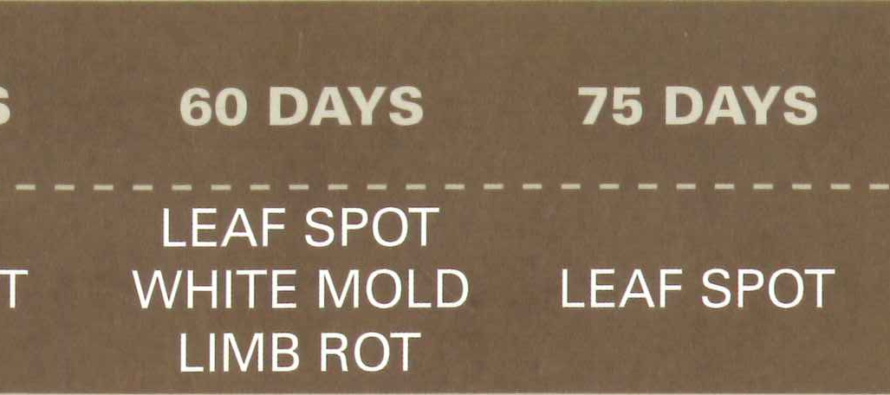Early Leaf Spot of Peanut

Synopsis:
- Is caused by a fungus, Cercospora arachidicola.
- Defoliates infected leaflets fairly quickly.
- Is one of the reasons, along with late leaf spot, for the development of the traditional two week spray schedule in established peanut growing areas (see Figure 1).
- Lesion appearance:
- Usually infects upper side of leaf.
- Often surrounded by a chlorotic ring with a dark chocolate brown center.
- Conidiophores are not as dense as late leaf spot (which looks more like a dark velvet), but are present in the usual Cercospora configuration.
- Prefers lower canopy, working from near ground upwards.
- For people who have been looking hard at different lesions throughout the season, it will “just look differentâ€.
Figure 1. Conventional spray program for peanuts.

Current news:
- Found last week in Beaumont, MS area and in several fields in George County.
- Beaumont: In a plot area where the disease was found after Issac in 2012. Crop residue was tilled under. A winter cover crop was planted. Area was fallowed for some weeks before planting peanuts.
- Area was free from disease two weeks ago.
- As of Friday morning was some slight defoliation in the lower canopy.
- Lesions spread from lower canopy to about 2/3.
- Fruiting on lower most leaves.
- Evenly dispersed around plots, with no obvious foci. So was not a new introduction.
- Lucedale
- Found in two fields. Only checked two fields before rained/lightened out.
- Infection was light, in the upper 1/2 to 2/3 canopy.
- Fruiting just starting.
What does early leaf spot look like and how do I tell it form other common leaf spots?
Figure 2 show common leaf spots, those caused by Funky Leaf Spot or Leaf Scorch.
Figure 3-5 images of early leaf spot in canopy, petiole, and on leaflet.
Do I have early leaf spot?
I have collected some samples of early leaf spot. I will visit some urban locations in the Delta with some samples. I will not take them into the field. Come examine them at one of my stops. If you still have some questions, I will be glad to go to the field with you.
Tuesday, at 10:00 we will be at the Clarksdale Extension Office. From 10:00 to 12:00 we will do a “walk-about†in peanut fields looking at disease problems, and collect samples. We will take the samples back to the Extension office and compare the field samples to the early leaf spot samples.
Tuesday, at about 2:00 I will be at the Tunica Extension office (1221 Kenny Hill Avenue, Suite 3
Tunica, MS 38676). Come look at the early leaf spot samples if you are interested. Unless we have a lot of field calls, I will leave at 4:00.
About 5:15 I will be at the Waffle House in Senatobia.
Wednesday morning, I will be in Greenwood.
I will watch this blog for comments and requests for other stops/visits.
Figure 2. Typical Funky Leaf Spot OR Leaf Scorch symptoms. Note that there are chlorotic rings around the lesion, but that the next area is brown. Only the center is dark, but not dark chocolate brown. As an aside, the black spots on the right two leaflets are Macrophomina leaf spot.
Figure 3. Early leaf spot. Notice typical position in canopy. Notice that these lesions also have a chlorotic ring. Center of the lesion is uniformly dark, somewhat a dark chocolate brown.The tips of many leaves have a yellow blush and some slight folded leaf tips are from leaf hopper damage.

Figure 4. Early leaf spot on a petiole with leaflets. Notice the chlorotic circle around most of the lesions. The center of the lesions is a dark brown. The whitish “spots†inside the dark area of the lesions are fruiting bodies. For some reason the fruiting bodies are visible in these images but you needed a magnifying glass to see them in the field.

Figure 5. Peanut leaflet infected with early leaf spot. For some reason the fruiting bodies are visible in these images but you needed a magnifying glass to see them in the field.






Let me tell You a sad story ! There are no comments yet, but You can be first one to comment this article.
Write a comment